11 Willow Varieties With Interesting Attributes And Habits – Some Can Be Grown As Shrubs

Reviewed By DAN ORI

Dan has over 27 years’ under his belt caring for plants and gardens. Working as a Horticultural Instructor and Consultant, he draws on a diverse range of experience that includes working as a Head Gardener, Tree Surgeon, Garden Centre Trouble Shooter, and writer of academic papers. Dan has a Level 3 Diploma in Horticulture and is currently a candidate for the RHS’s most prestigious award – The Master of Horticulture.
IN THIS GUIDE
WILLOW GUIDES
Container Growing
Pruning
Varieties
– Corkscrew
– Flamingo
– Weeping
‘The Willow Tree’ as we know it is actually rather more than one tree – over a hundred in fact.
But that is far from all: Willow Trees are members of Genus Salix which comprises over 400 species – many of them are shrubs, both upright and creeping.1Harris, S. (n.d.-d). Salix species. Oxford University Plants. Retrieved March 27, 2023, from https://herbaria.plants.ox.ac.uk/bol/plants400/Profiles/st/Salix
Many Willow varieties are first-rate landscaping and architectural trees for any number of reasons.
These attractively-branching small to medium-large trees are shapely and elegant to begin with, and they are amenable to pruning and shaping.
Some species grow to over 15m while other varieties’ sizes are very much on the small side so they make perfect trees or large shrubs for small front yards.

Some species are pruned and trimmed to create living hedges.
Many varieties’ trees bend and sway while producing a melancholy sough as the wind rustles through them which is a quality not many trees share with the Willow.
And then there are those hues the foliage comes in – yellow-green, bright green, chalk green, pink, silvery, bronzy, and golden!
Many species’ foliage also changes in shade with the season, usually becoming progressively deeper and warmer.

The various Willow species have weak wood and weaker wood.
But the flip side is that Willow wood is pliable with much more flex than other woods and it is also lightweight; indeed, a particular type of willow, Salix alba, is the only wood used for making cricket bats.
In addition, Willow is the wood of choice for baskets and wickerwork, and also for divining rods, wands, and woodcraft including sculpture.
1) Golden Weeping Willow
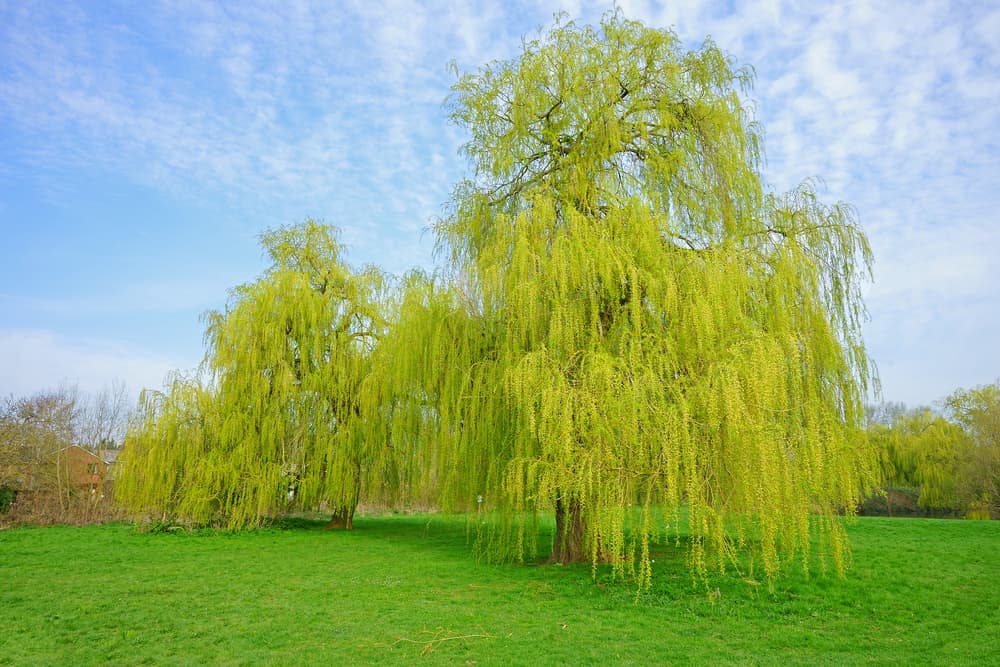
Botanical Name: S. × sepulcralis var. chrysocoma
One of the more robust Willow species, and is also one of the most aesthetic and popular.
Those well-known weeping branches dripping with weepy foliage, as it were, make a beautiful sight and more so because of the golden sheen that the young green leaves have, and which they revert to in autumn.
A height of 8-10m is usual for this species but some specimens can grow to 15m.
Uncommonly for willows, this variety is usually monoecious though dioecious types are also found.
This variety has received the RHS Award of Garden Merit.
2) Corkscrew Willow
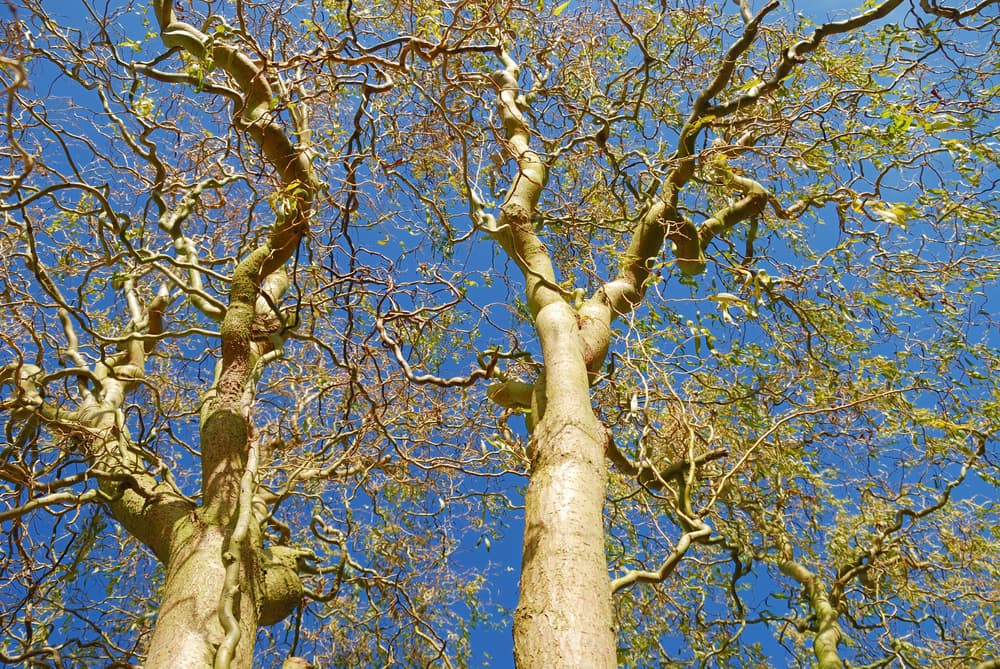
Botanical Name: S. babylonica var. pekinensis ‘Tortuosa’
The Corkscrew Willow exhibits an upright habit but with a ‘twist’: the limbs, branches and even the leaves are incredibly contorted and twisted as if they have been tortured, hence the name of the tree.
Because of this rare attribute, it is the form and figure of the tree that is of sculptural interest; as a result, it is when the tree sheds its leaves in autumn that the very uncommon character of this tree comes into focus.
It is relatively fast-growing and reaches a height of 12-15m.
It bears mentioning that the extreme and extraordinary contrast that two species of the same genus, Weeping Willow and Tortured Willow, make with one another is unparalleled in the Plant Kingdom as one is entirely graceful and flowing and the other so impossibly gnarled and jagged.
3) Goat / Pussy Willow
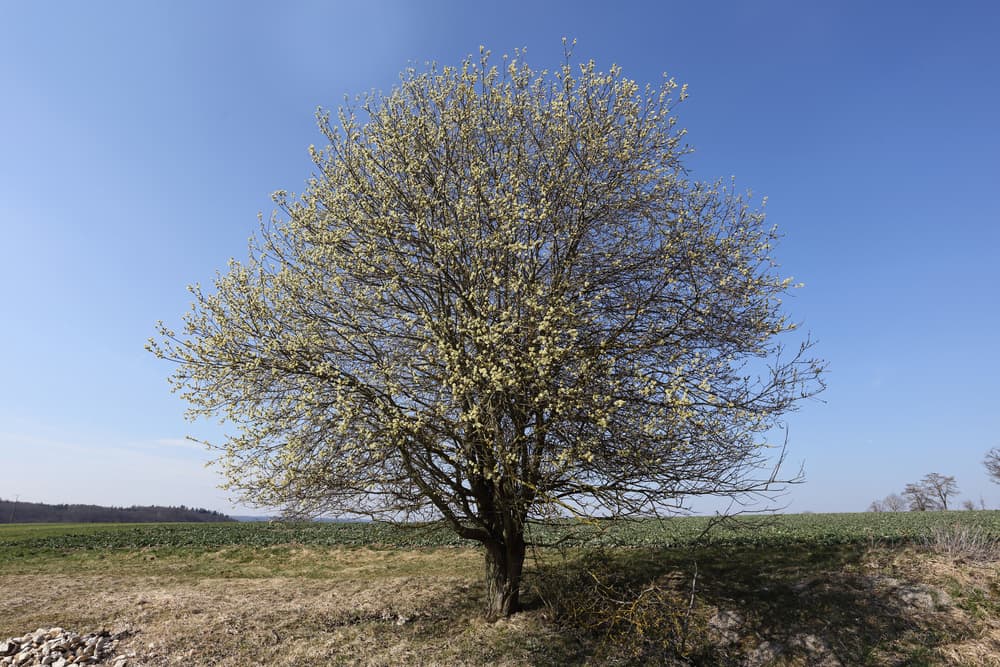
Botanical Name: S. caprea
One of the species native to the British Isles.
It has two distinctive features.
First, unlike most Willows this one has broad, oval leaves; second, it produces fairly big, furry cream-grey catkins with the male ones being bigger and thicker.
These bring to mind a cats’ tails, hence the tree’s informal name.
It can be pruned to grow as a shrub though it is usually (fortunately) grown as a tree.
It is on the small side, reaching a height of 8-12m.
4) White Willow
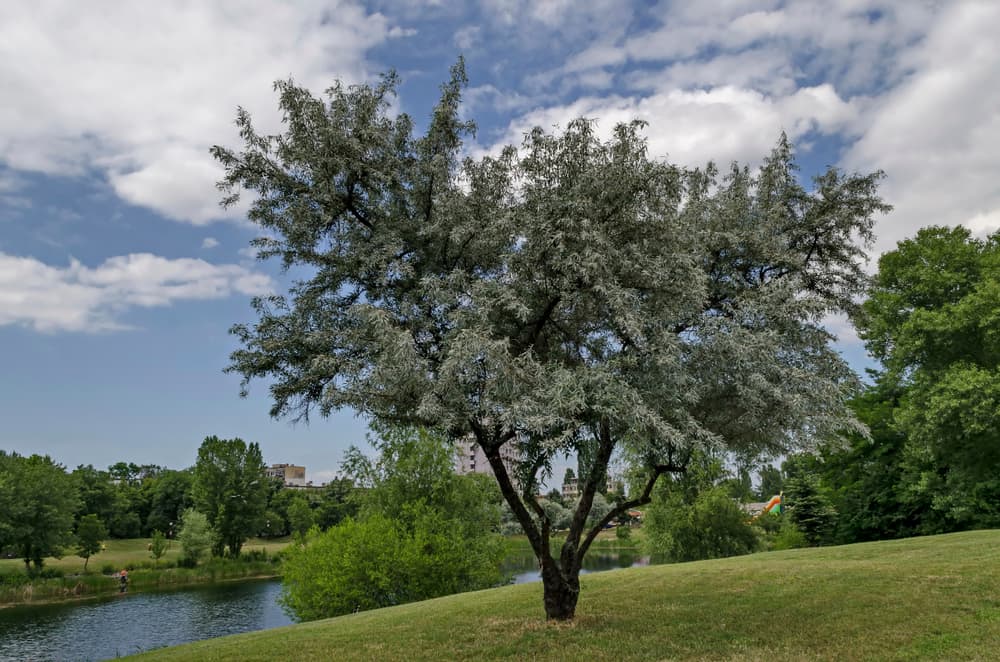
Botanical Name: S. alba
This is a native of the British Isles where it is found in nature by riverbanks and other waterways.
It has some interesting attributes and even more interesting habits.
It is one of the fastest-growing Willows and also one of the largest, attaining heights between 20-25m at maturity.
As a result, in high winds, even by Willow standards, its boughs break frequently.
For this reason it is usually carefully pruned.
Its narrowly lanceolate leaves, though of a dull, bluish-green hue, appear silvery-white from a distance, especially the undersides, and this effect gives this species its informal name.
5) Flamingo Willow
Botanical Name: S. integra ‘Hakuro Nishiki’

The Flamingo Willow is technically a shrub but makes the smallest of trees with an average height of 2m, topping out at 2.5m.
The narrow, lanceolate leaves at up to 10cm long further set off the small size of the tree.
The defining characteristic of this highly ornamental tree is colours – and more colours.
Fresh spring leaves are pink; as they mature they become variegated pink and green.
At the same time its catkins are a creamy yellow or golden yellow.
Summer foliage is predominantly green but with pink and creamy variegation, and when the leaves start to fall in autumn, you still get colour as the exposed branches are a rich bronzy reddish-orange.
This little tree is ideal for a townhome’s courtyard garden. RHS Award of Garden Merit.
“This variety works well as a top grafted tree in a container and can be trained to give a spiky lollypop look,” shares Horticultural Consultant Dan Ori.
“These flamingo lollipops can be utilised well in pairs for framing entrances. I still prefer this plant grown as a shrub, but no matter how you grow it, I recommend cutting it back each winter to enjoy the best colourful growth.”
6) Blue-Stem Willow
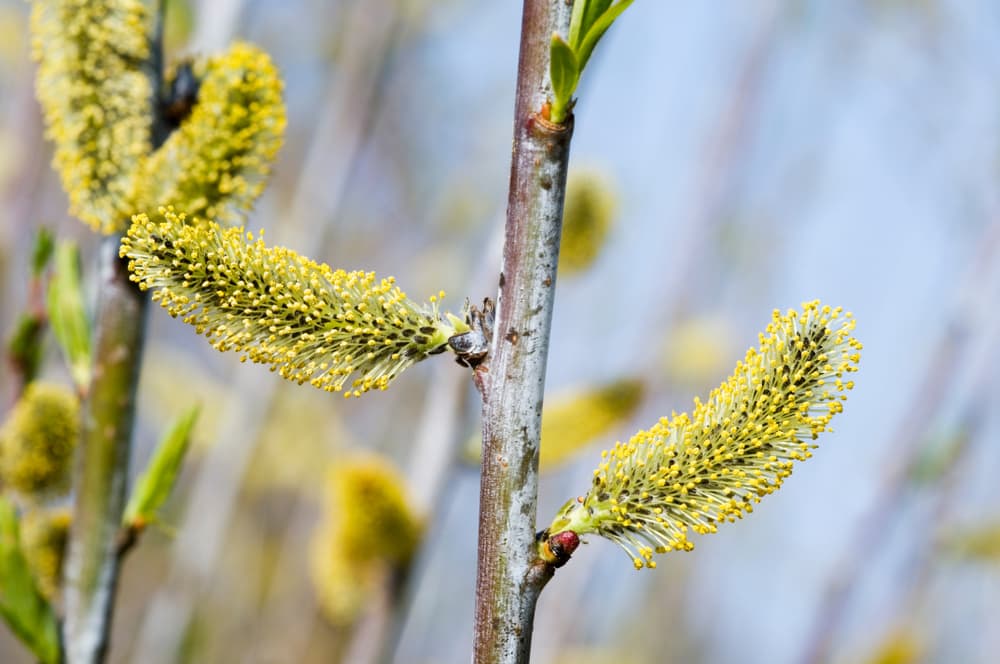
Botanical Name: S. irrorata
Our last entry, is not really a ‘Willow Tree’; rather, it must be called a Willow shrub.
Tree or shrub, this species is also spectacular because of its season-long display of colours, and it too is an excellent choice for a townhome’s courtyard garden as it grows to only 2-2.5m with a spread of 3-4m.
Numerous branches emerge from ground level.
Even as they sprout they are of a light blue through lilac to lavender hue, a colouring it maintains in some or another shade through to autumn when it is particularly striking when the branches are bare.
In late winter it bears small white flowers.
Spring ushers in even more colours as this Willow produces grey catkins with prominent red anthers.
Yet another recipient of the RHS Award of Garden Merit.
More Willow Types
7) Basket Willow
Botanical Name: S. viminalis
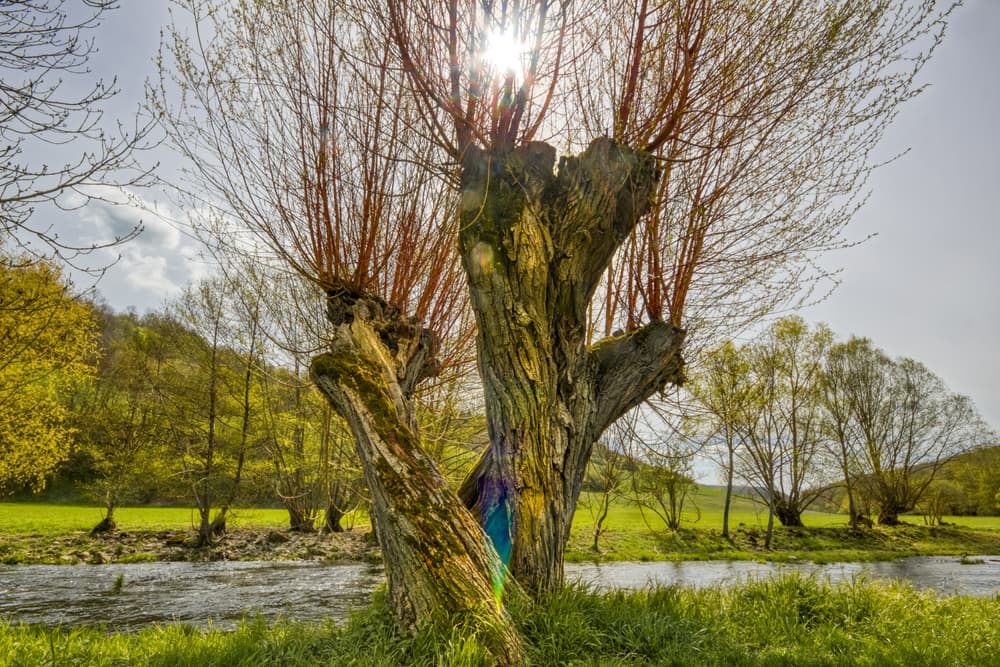
8) Weeping Willow
Botanical Name: S. babylonica
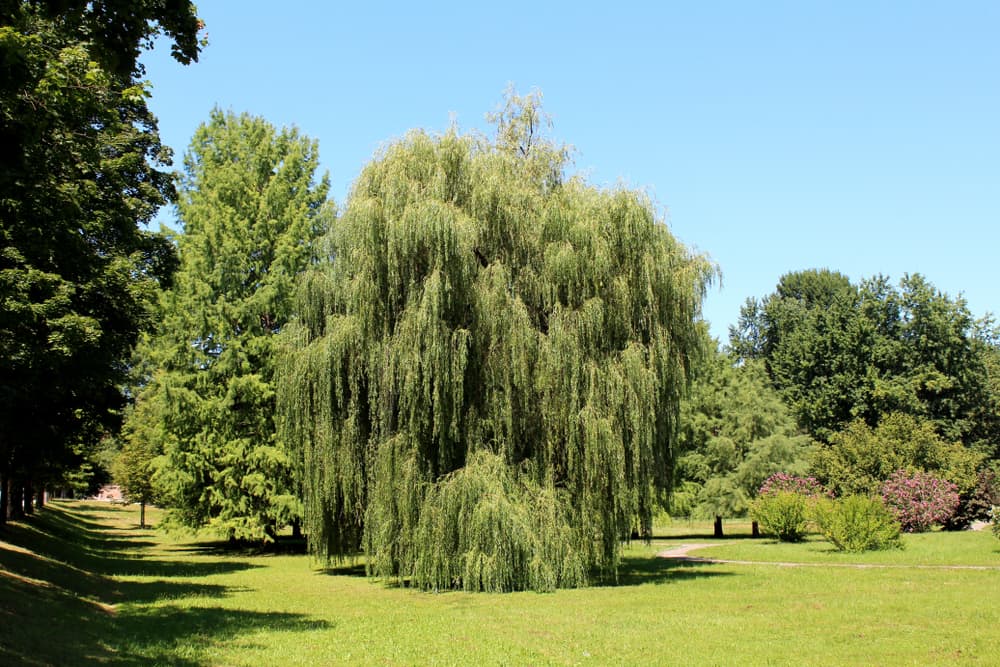
9) Eared Willow
Botanical Name: S. aurita
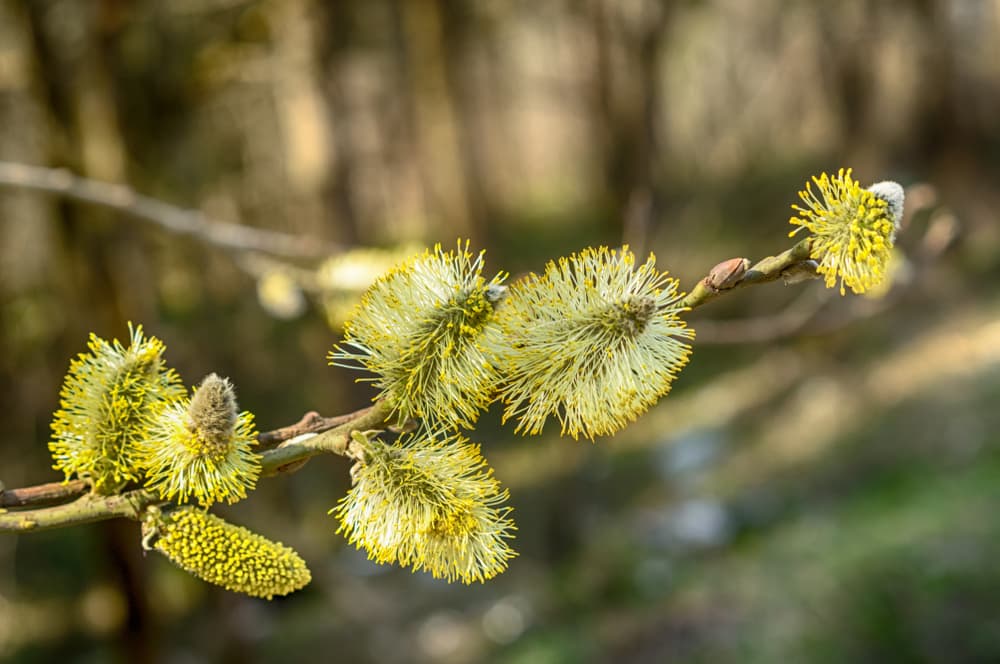
10) Purple Willow
Botanical Name: S. purpurea
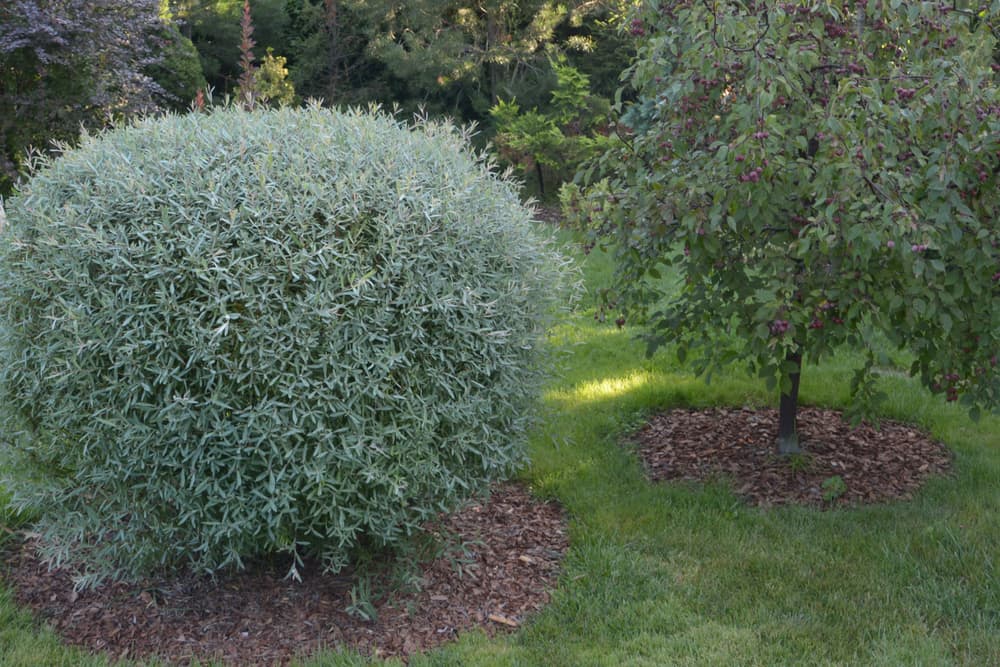
11) Crack Willow
Botanical Name: S. fragilis

Remember that these trees are notorious for snapped limbs after a minor storm or even high winds – so be careful where you grow them!
References
- 1Harris, S. (n.d.-d). Salix species. Oxford University Plants. Retrieved March 27, 2023, from https://herbaria.plants.ox.ac.uk/bol/plants400/Profiles/st/Salix

